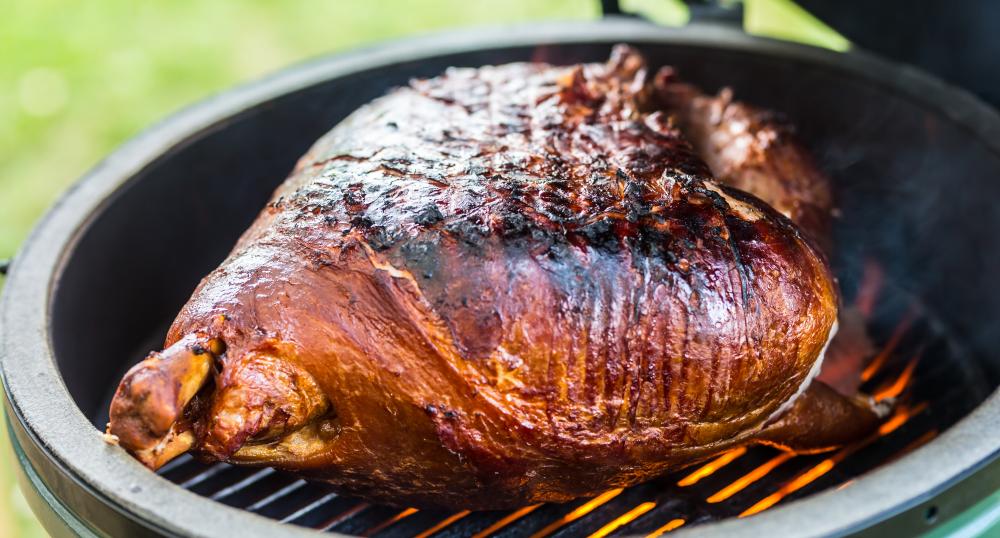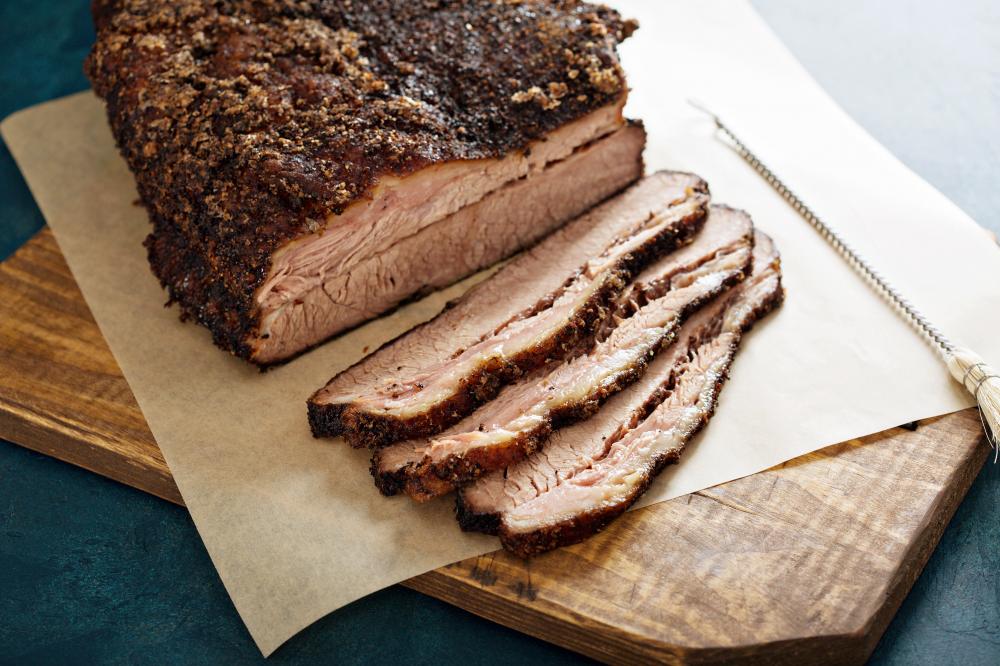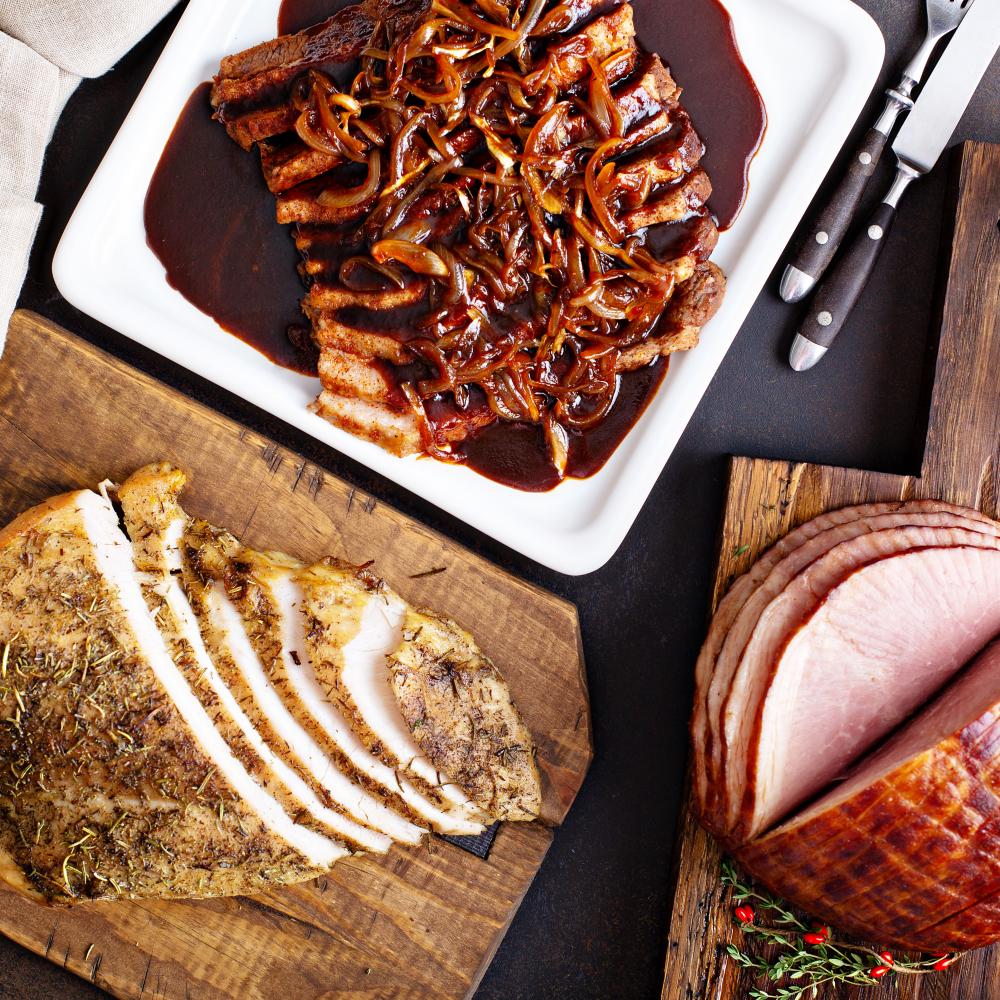
Selecting the Perfect Cut
At Brisket Pro, we believe starting with the right cut is crucial when figuring out how to make brisket tender in smoker. The journey to a tender brisket begins at the butcher’s counter. Look for a cut with a good amount of marbling; this fat weaves throughout the meat and melts during cooking, naturally basting the brisket and keeping it moist. A choice or prime grade brisket usually has the most marbling. Don’t shy away from a cut that seems too fatty; much of that fat will render off, leaving behind flavor and tenderness.
Preparation is Key
Trimming the Fat
Though fat is necessary for flavor and moisture, too much can prevent seasonings and smoke from penetrating the meat. I recommend trimming the fat cap down to about a quarter inch thick. This process might seem daunting for beginners, but it’s a simple step that can dramatically improve your smoking results.
Seasoning Your Brisket
Next, let’s talk about the rub. A good rub not only adds flavor but also helps form the coveted ‘bark’ or crust on the exterior of the brisket. I like to keep it simple with a mix of salt, black pepper, garlic powder, and smoked paprika. Apply your rub generously, making sure to cover every nook and cranny. A good layer of seasoning acts as a barrier, locking in moisture and fat.
Mastering the Smoke
Knowing how to make brisket tender in smoker involves more than just preparation; it’s an art of patience and precision. Maintaining a consistent temperature between 225°F and 250°F is key. I often see beginners making the mistake of peeking frequently. Each look can extend cooking time and disrupt temperature consistency. Instead, trust your setup and let the smoker work its magic.
An often-overlooked tip is choosing the right wood. For brisket, hardwoods like oak or hickory offer a robust flavor without overwhelming the meat. Fruit woods can be used for a more subtle taste. The wood should complement your rub and bring out the brisket’s natural flavors.
Remember, when it comes to smoking brisket, less is often more. Resist the urge to constantly add wood chips. Oversmoking can lead to a bitter taste. A steady, light smoke will impart that delicious smoky flavor we all crave in a tender brisket.
The Crucial Rest
After hours of smoking, it might be tempting to slice into that juicy brisket immediately, but this is where patience truly pays off. Allowing your brisket to rest is an integral part of how to make brisket tender in smoker. Wrap the brisket in butcher paper or foil and let it sit for at least an hour, though two is better. This rest period lets the juices redistribute throughout the meat, ensuring every bite is moist and flavorful. Skipping this step can result in a dryer, less flavorful brisket.
During my years at Brisket Pro, I’ve learned that some of the most memorable briskets are those given the time to rest properly. It’s a simple step, but it makes all the difference in achieving that perfect tenderness and juiciness. Learn how to cook brisket in oven to perfection on our site.
Final Thoughts
Remember, learning how to make brisket tender in smoker is a journey. Each brisket you smoke teaches you something new about the process, the meat, and your personal preferences. Embrace the learning curve, and don’t be afraid to experiment. Smoking brisket is as much about the love of the craft as it is about the delicious results. Happy smoking!
Here at Brisket Pro, we’re passionate about all things brisket. Whether you’re a seasoned smoker or just starting out, we’re here to share our knowledge and help you on your journey to brisket mastery. Remember, the secret to tender brisket in a smoker lies in the cut, the prep, the patience, and the passion.

The Art of Brisket Tenderness
At Brisket Pro, we often receive the question, does brisket get more tender the longer you cook it? The answer is nuanced, and understanding the interplay of heat, time, and meat chemistry is essential. Brisket, with its high collagen content, undergoes a transformation when cooked slowly over low heat. This process, known as collagen breakdown, turns tough connective tissue into gelatin, contributing to the meat’s tenderness and moisture.
In our explorations and discussions, we’ve found that there is an optimal point in cooking where brisket reaches peak tenderness. The key is maintaining a balance between breaking down the collagen without drying out the meat. Thus, while it’s true that brisket gets more tender the longer you cook it, there’s a threshold beyond which the meat starts to become overly dry and tough again.
Methods for Maximizing Tenderness
Low and Slow Cooking
Traditional wisdom suggests the low and slow method as the best approach to achieve tender brisket. Cooking brisket at a lower temperature for a longer period allows for a gradual breakdown of tough fibers without losing moisture. Regulatory checks with a reliable thermometer ensure the brisket doesn’t overcook. It’s a delicate dance, but when performed correctly, the result is a succulently tender brisket that’s worth the wait.
Wrapping Techniques
To counteract the stall – a period during cooking when the brisket’s internal temperature plateaus – many pitmasters employ wrapping techniques. Wrapping brisket in butcher paper or aluminum foil, often referred to as the Texas Crutch, can expedite the cooking process and help retain moisture. This technique can be particularly useful in achieving the desired tenderness without extending the cook time unnecessarily.
Innovative Approaches to Tenderness
Does brisket get more tender the longer you cook it? Yes, but with a twist. Some pitmasters are exploring alternatives to traditional methods, such as the ‘hot and fast’ technique. This approach involves cooking brisket at higher temperatures for a shorter duration. While purists may debate its merits, our experiments and taste tests reveal that, when done correctly, it can yield surprisingly tender results. The trick lies in closely monitoring the brisket’s internal temperature and employing a timely wrap to preserve juiciness.
We’ve also observed that the choice of brisket, whether it’s prime, choice, or select grade, has a substantial impact on tenderness. Prime grade briskets, with their higher fat content, tend to be more forgiving and yield a more tender outcome. Additionally, the incorporation of a marinade or injection can introduce additional moisture into the brisket, aiding in tenderness throughout the cooking process.
Lastly, does brisket get more tender the longer you cook it? This is true to a point, but the ultimate tenderness is achieved by letting the brisket rest after cooking. Resting allows the juices to redistribute throughout the meat, ensuring that each slice is as succulent as possible. Our advice: practice patience at every step, from cooking to resting, for that perfect brisket tenderness.
- Low and Slow Method: A time-tested strategy for melting the collagen into gelatin, enhancing tenderness.
- Wrapping (Texas Crutch): Employing foil or butcher paper to overcome the stall and lock in moisture.
- Hot and Fast: An unconventional method that, with precise temperature control, can produce tender brisket in a shorter timeframe.
- Grade of Meat: Selecting a high-quality brisket is foundational for achieving tenderness and flavor.
- Resting: Allowing the brisket to rest post-cooking is crucial for juice redistribution.
In sum, while the principle of ‘the longer, the tenderer’ does apply, it’s enveloped in a cloak of culinary artistry and scientific understanding. At Brisket Pro, we believe in pushing the boundaries of traditional brisket cooking, constantly seeking new methods, and refining old ones to achieve the holy grail of brisket perfection: a tender, juicy, flavor-packed delight that pays homage to its humble beginnings.

What is the trick to smoking a tender brisket?
At Brisket Pro, we often say that the secret to a tender brisket in the smoker comes down to patience and understanding the meat. First off, selecting the right cut with ample marbling is foundational. This internal fat melts during smoking, naturally basting the brisket, keeping it moist and tender. Beyond the cut, the magic lies in low and slow cooking. Maintaining a consistent temperature between 225°F and 250°F allows the tough collagen in the brisket to break down into gelatin without losing moisture. Wrapping the brisket, commonly known as the Texas Crutch, further into the cook can also help push past the stall while locking in juices. And finally, never underestimate the power of rest. Allowing the brisket to rest wrapped for at least an hour ensures the redistribution of juices, making every bite tender and juicy.
How do you keep brisket tender when smoking?
Keeping brisket tender involves a combination of careful preparation and controlled smoking. Before the brisket even sees the smoker, trim the fat cap down to about a quarter inch to ensure smoke and seasonings penetrate the meat adequately. Applying a generous layer of rub not only adds flavor but also helps to seal in the juices. During the smoke, it’s crucial to resist the temptation to open the smoker too often; every peek lets out heat and smoke that are vital for cooking and flavoring the meat. If the brisket appears to be drying out, consider spritzing it with apple cider vinegar or beef broth to add moisture. Remember, the ultimate goal is to maintain a humid environment inside the smoker for the brisket to stay tender.
Does brisket get more tender the longer you smoke it?
This is a nuanced question. Yes, brisket does become more tender the longer it’s cooked, up to a point. The process of low and slow smoking allows the tough connective tissues and collagen in the brisket to break down into gelatin, which imparts both moisture and tenderness. However, there’s a fine line here. Beyond a certain point, you risk drying out the meat, making it tough despite being cooked for longer. The key is monitoring the meat’s internal temperature and maintaining the right cooking environment. Once the brisket reaches an internal temperature around 195°F to 205°F, it’s usually a good indicator that the collagen has broken down properly, and the meat should be tender. After reaching this stage, it’s crucial to let the brisket rest to distribute the juices evenly.
Why is my smoked brisket always tough?
If your smoked brisket is coming out tough, there are a few potential culprits. One common mistake is not smoking the brisket long enough. Brisket has a lot of connective tissue that requires time to break down into gelatin, which contributes to the meat’s tenderness. Rushing this process by cooking at too high a temperature or not allowing enough time can leave you with a tough brisket. Another possibility could be the meat’s quality. A brisket with insufficient marbling (fat content) may not have enough fat to melt and keep the meat moist during the long smoking process. Additionally, opening the smoker frequently can cause temperature fluctuations that interfere with the cooking process, potentially leading to a tougher brisket. Finally, not allowing the brisket to rest after smoking can result in juices not redistributing properly, making the meat seem tougher.
What additional steps can be taken to ensure brisket tenderness in a smoker?
To further ensure brisket tenderness, consider the meat’s grade. Prime grade briskets, with higher fat content, are more forgiving during the smoking process and can result in a more tender outcome. Also, injecting the brisket with a marinade can introduce additional moisture and flavor deep into the meat, aiding in tenderness. An often overlooked step is the choice of wood. Using the right type of wood, like oak or hickory for a stronger flavor or fruit woods for a more subtle taste, can complement the brisket’s natural flavors without overpowering it. Finally, consistently monitoring the smoker’s temperature with a reliable thermometer and using a water pan can help maintain the ideal cooking environment for a tender brisket. Remember, each brisket is a new opportunity to refine your technique, and small adjustments can lead to big improvements in tenderness and flavor.
Brisket Resources
- US Department of Agriculture – Official website providing information on meat grading and selection.
- Serious Eats – Culinary website offering in-depth guides and tips on brisket preparation.
- Beef. It’s What’s For Dinner. – Resource for beef recipes, cuts, and cooking techniques.
- Food Network – Comprehensive collection of recipes and cooking advice from professional chefs.
- University of Georgia Extension – Research-based information on meat science and cooking methods.
